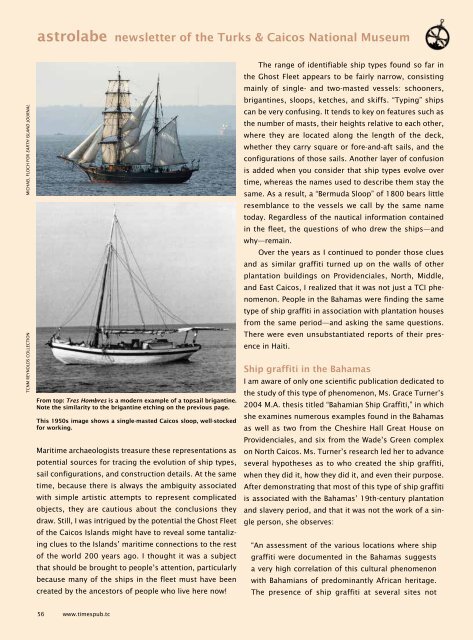Times of the Islands Fall 2016
Presents the "soul of the Turks & Caicos Islands" with in-depth features about local people, culture, history, environment, businesses, resorts, restaurants and activities.
Presents the "soul of the Turks & Caicos Islands" with in-depth features about local people, culture, history, environment, businesses, resorts, restaurants and activities.
You also want an ePaper? Increase the reach of your titles
YUMPU automatically turns print PDFs into web optimized ePapers that Google loves.
astrolabe newsletter <strong>of</strong> <strong>the</strong> Turks & Caicos National Museum<br />
MICHAEL FLOCH FOR EARTH ISLAND JOURNAL<br />
TCNM REYNOLDS COLLECTION<br />
From top: Tres Hombres is a modern example <strong>of</strong> a topsail brigantine.<br />
Note <strong>the</strong> similarity to <strong>the</strong> brigantine etching on <strong>the</strong> previous page.<br />
This 1950s image shows a single-masted Caicos sloop, well-stocked<br />
for working.<br />
Maritime archaeologists treasure <strong>the</strong>se representations as<br />
potential sources for tracing <strong>the</strong> evolution <strong>of</strong> ship types,<br />
sail configurations, and construction details. At <strong>the</strong> same<br />
time, because <strong>the</strong>re is always <strong>the</strong> ambiguity associated<br />
with simple artistic attempts to represent complicated<br />
objects, <strong>the</strong>y are cautious about <strong>the</strong> conclusions <strong>the</strong>y<br />
draw. Still, I was intrigued by <strong>the</strong> potential <strong>the</strong> Ghost Fleet<br />
<strong>of</strong> <strong>the</strong> Caicos <strong>Islands</strong> might have to reveal some tantalizing<br />
clues to <strong>the</strong> <strong>Islands</strong>’ maritime connections to <strong>the</strong> rest<br />
<strong>of</strong> <strong>the</strong> world 200 years ago. I thought it was a subject<br />
that should be brought to people’s attention, particularly<br />
because many <strong>of</strong> <strong>the</strong> ships in <strong>the</strong> fleet must have been<br />
created by <strong>the</strong> ancestors <strong>of</strong> people who live here now!<br />
The range <strong>of</strong> identifiable ship types found so far in<br />
<strong>the</strong> Ghost Fleet appears to be fairly narrow, consisting<br />
mainly <strong>of</strong> single- and two-masted vessels: schooners,<br />
brigantines, sloops, ketches, and skiffs. “Typing” ships<br />
can be very confusing. It tends to key on features such as<br />
<strong>the</strong> number <strong>of</strong> masts, <strong>the</strong>ir heights relative to each o<strong>the</strong>r,<br />
where <strong>the</strong>y are located along <strong>the</strong> length <strong>of</strong> <strong>the</strong> deck,<br />
whe<strong>the</strong>r <strong>the</strong>y carry square or fore-and-aft sails, and <strong>the</strong><br />
configurations <strong>of</strong> those sails. Ano<strong>the</strong>r layer <strong>of</strong> confusion<br />
is added when you consider that ship types evolve over<br />
time, whereas <strong>the</strong> names used to describe <strong>the</strong>m stay <strong>the</strong><br />
same. As a result, a “Bermuda Sloop” <strong>of</strong> 1800 bears little<br />
resemblance to <strong>the</strong> vessels we call by <strong>the</strong> same name<br />
today. Regardless <strong>of</strong> <strong>the</strong> nautical information contained<br />
in <strong>the</strong> fleet, <strong>the</strong> questions <strong>of</strong> who drew <strong>the</strong> ships—and<br />
why—remain.<br />
Over <strong>the</strong> years as I continued to ponder those clues<br />
and as similar graffiti turned up on <strong>the</strong> walls <strong>of</strong> o<strong>the</strong>r<br />
plantation buildings on Providenciales, North, Middle,<br />
and East Caicos, I realized that it was not just a TCI phenomenon.<br />
People in <strong>the</strong> Bahamas were finding <strong>the</strong> same<br />
type <strong>of</strong> ship graffiti in association with plantation houses<br />
from <strong>the</strong> same period—and asking <strong>the</strong> same questions.<br />
There were even unsubstantiated reports <strong>of</strong> <strong>the</strong>ir presence<br />
in Haiti.<br />
Ship graffiti in <strong>the</strong> Bahamas<br />
I am aware <strong>of</strong> only one scientific publication dedicated to<br />
<strong>the</strong> study <strong>of</strong> this type <strong>of</strong> phenomenon, Ms. Grace Turner’s<br />
2004 M.A. <strong>the</strong>sis titled “Bahamian Ship Graffiti,” in which<br />
she examines numerous examples found in <strong>the</strong> Bahamas<br />
as well as two from <strong>the</strong> Cheshire Hall Great House on<br />
Providenciales, and six from <strong>the</strong> Wade’s Green complex<br />
on North Caicos. Ms. Turner’s research led her to advance<br />
several hypo<strong>the</strong>ses as to who created <strong>the</strong> ship graffiti,<br />
when <strong>the</strong>y did it, how <strong>the</strong>y did it, and even <strong>the</strong>ir purpose.<br />
After demonstrating that most <strong>of</strong> this type <strong>of</strong> ship graffiti<br />
is associated with <strong>the</strong> Bahamas’ 19th-century plantation<br />
and slavery period, and that it was not <strong>the</strong> work <strong>of</strong> a single<br />
person, she observes:<br />
“An assessment <strong>of</strong> <strong>the</strong> various locations where ship<br />
graffiti were documented in <strong>the</strong> Bahamas suggests<br />
a very high correlation <strong>of</strong> this cultural phenomenon<br />
with Bahamians <strong>of</strong> predominantly African heritage.<br />
The presence <strong>of</strong> ship graffiti at several sites not<br />
56 www.timespub.tc

















